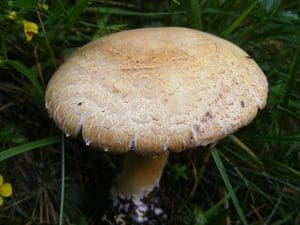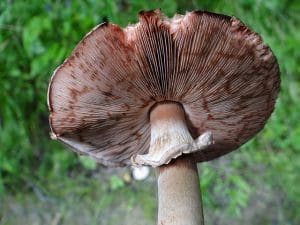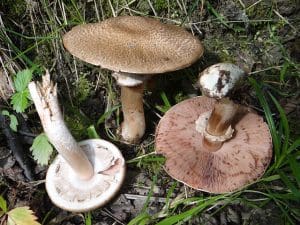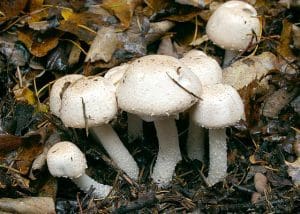Wood Mushroom / Spring / Summer / Autumn / Edible
The Wood Mushroom is an edible member of the Agaric family. Probably one of the most common large woodland mushrooms in the UK.
Scientific Name
Agaricus silvaticus
Common Names
Wood Mushroom, Scaly Wood mushroom, Blushing Wood mushroom, or Pinewood mushroom.
Family
Agaricaceae
Habitat
They are saprotrophic and can be found in all types of woodlands, quite often in large troops.
Description
An edible member of the Agaric family. Probably one of the most common large woodland mushrooms in the UK.
Our Foraging Video for the Wood Mushroom
Identifying Features of the Wood Mushroom:
Cap:
Spherical when young they flatten out almost completely with age. They are white to tan when young but tend to go yellow with maturity.

Stem:
A similar colour to the caps, again yellowing as they age. Bulbous at the base with a pendulous ring that is quite fragile.

Gills:
The gills are white when young, turning pink and then brown with age, fairly crowded and free from the stem.

Smell:
Aniseed.
Spores:
Chocolate brown.
Uses
In food
They have a lovely mushroomy flavour similar to store-bought mushrooms and they work well in most dishes. My favourite way to enjoy them is to fry them at very high heat with butter and cow parsley and serve them on toast.
They must be thoroughly cooked before consumption.
Harvesting
They have a very short shelf life so need to be used within 48 hours of picking.
Known hazards
They have been known to cause gastric upset in a small number of people so if it’s your first time trying them you are advised to try only a small portion and wait for 24 hours to see whether there are any adverse reactions
Potential lookalikes
Other Agaricus species do look similar, most are edible but care needs to be taken to avoid the toxic Yellow Stainer (Agaricus xanthodermus) The Yellow Stainer as the name suggests stains yellow when it is damaged and smells like iodine.
Extra Notes
The species name Silvaticus means ‘of the woods’ in Latin.








Leave a Reply
You must be logged in to post a comment.